Skryne
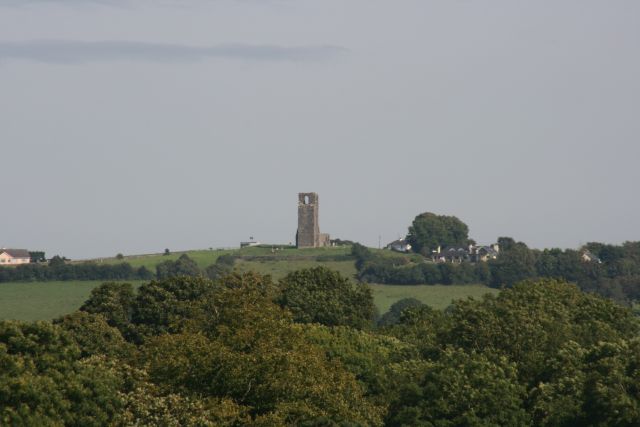
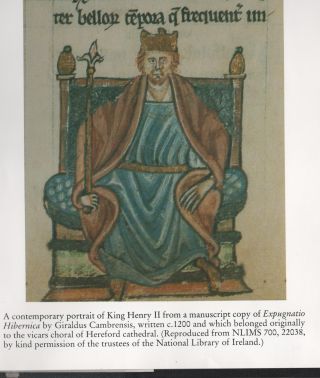
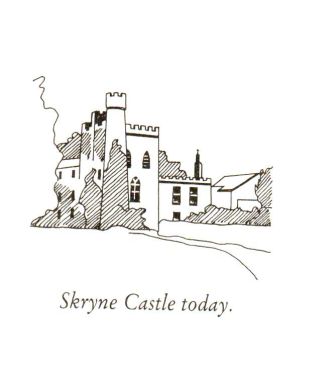
At Skryne, a castle was built some time between 1172 and 1175. The de Feipos held the Barony until the close if the 1300s when an heiress carried the title to the Marwards, who were Barons of Skryne until the 1600s, when the title died out.
After this the castle seems to have fallen into disrepair. It was restored early in the 1800's when the present house was built around the old keep. The thickness of the walls proclaiming the age of the ancient tower.
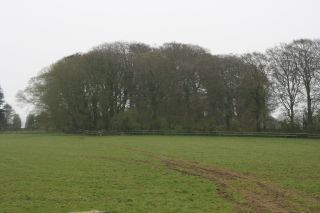
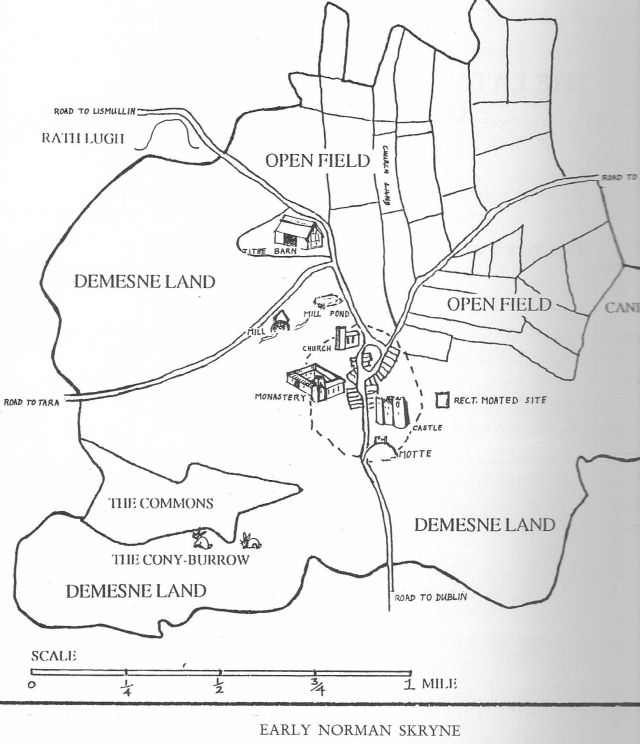
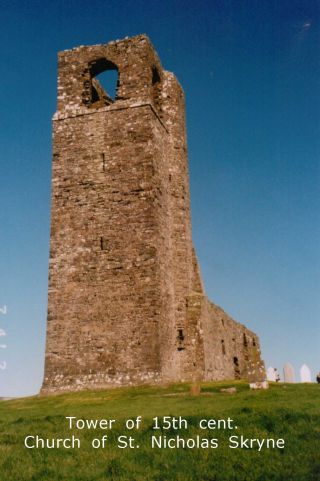
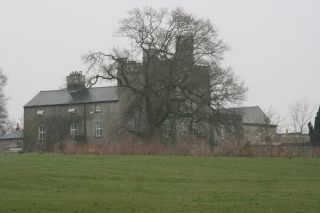
Riocht na Midhe, 2016, p. 65.
Legislation enacted by Edward IV in 1465 “every Irishman dwelling within the Pale shall take to him an English surname of one Towne, as Sutton, Chester, Trym, Skryne, Corke, Kinsale;......”
Excavations.ie number: 2006:1637 License number: A008/018, E3071
Author: Tara O’Neill, Archaeological Consultancy Services Ltd, 21 Boyne Business Park, Greenhills, Drogheda.
Site type: Settlement activity
ITM: E 694198m, N 759772m.
Excavations.ie number: 2006:1638 License number: A008/019, E3072
Author: Tara O’Neill, Archaeological Consultancy Services Ltd, 21 Boyne Business Park, Greenhills, Drogheda.
Site type: Prehistoric structure and settlement activity
ITM: E 694035m, N 760236m.
County: Meath Site name: TESTING AREA 7, SKREEN
xcavations.ie number: 2004:1339 License number: 04E0424
Author: Linda Clarke, Archaeological Consultancy Services Ltd, Unit 21, Boyne Business Park, Greenhills, Drogheda, Co. Louth.
Site type: Pit features, hearths and linear features
ITM: E 694218m, N 759493m
Latitude, Longitude (decimal degrees): 53.576850, -6.577310.
Testing Area 7 is located in the townland of Skreen between Chainages 27050 and 28150. Within this area, 11,418m2 out of a total of 89,106m2 was test-trenched, providing an assessment coverage of 13%.
A potential archaeological site had previously been identified as a result of the geophysical survey in Testing Area 7, Field 3 (Area 18). A large ditch, the function of which is unknown, and a shallow linear feature were contained within this area. The presence of these features was confirmed in the assessment phase of works. Three pit features were also identified and these features were designated Skreen 2. No finds were recovered from any of the features that were sectioned.
Six features of archaeological interest were identified in Testing Area 7, Field 1. This site was designated Skreen 1 and consisted of four pit features, a hearth and a small linear feature. These isolated features were at various locations throughout the field. No finds were recovered and the date of these features is uncertain.
http://www.excavations.ie/report/2004/Meath/0012462/
County: Meath Site name: TESTING AREA 8, SKREEN
Excavations.ie number: 2004:1340 License number: 04E0425
Author: Linda Clarke, Archaeological Consultancy Services Ltd, Unit 21, Boyne Business Park, Greenhills, Drogheda, Co. Louth.
Site type: Pit features and linear feature
ITM: E 693878m, N 760447m
Latitude, Longitude (decimal degrees): 53.585480, -6.582154.
Testing Area 8 was located within the townland of Skreen between Chainages 28150 and 28600. Within this area, 4094m2 of test-trenches were excavated out of a total of 30,394m2, providing an assessment coverage of 13.5%. Two possible archaeological sites, identified as a result of the geophysical survey, were contained within Testing Area 8. Area 16, Field 2, was visible on the geophysical data as several linear features that appeared to represent the remains of a field system or former field boundaries and several possible pits. Other linear features appeared to be related to modern ploughing. All of the linear features identified within this area during assessment were associated with drainage or agricultural activity and were not archaeological in nature. Area 17, Field 1, appeared on the geophysical data as three small pit features that were interpreted as possible archaeological features. No traces of these features were identified during the assessment phase of works.
*******
The Lewis Topographical Directory was first published in 1837 in two volumes, with an accompanying atlas. The first edition is available online. A second edition was published in 1842.
Lewis relied on the information provided by local contributors and on the earlier works published such as Coote's Statistical Survey (1801), Taylor and Skinner's Maps of the Road of Ireland (1777), Pigot's Trade Directory (1824) and other sources. He also used the various parliamentary reports and in particular the census of 1831 and the education returns of the 1820s and early 1830s. Local contributors were given the proof sheets for final comment and revision. The names of places are those in use prior to the publication of the Ordnance Survey Atlas in 1838. Distances are in Irish miles (the statute mile is 0.62 of an Irish mile).
Skreen, or Skryne, a parish, in the barony of Skreen, county of Meath, and province of Leinster, 3 miles (N.) from Dunshaughlin, on the roads from Dublin to Navan and from Drogheda to Summerhill; containing 1279 inhabitants. This parish was anciently called Scrinium Sancti Columbae, and appears to have derived that name from the shrine of St. Columb having been brought from England into Ireland, in 875, and deposited in the monastery here.
The Danes twice plundered this religious establishment during the eleventh century, and it was likewise ravaged by the inhabitants of Teaffia in 1058 and in 1152. On the settlement of Meath by Hugh de Lacy, this place became the property of Adam de Feypo, who erected a castle here; his family founded and endowed a friary for eremites of the order of St. Augustine. In the reign of Rich. II., mention is made of the “Irish town of Skryne;” in that of Hen. IV. notice is taken of its hundred court as a borough, and of its burgage rents; and in the records of the 1st of Hen. VI., 1423, “the Provost and Commonalty of the town of Scryme are ordered to be at Trim with all their power for its defence;” though at present it is a place of but little consideration.
The parish comprises 4235 statute acres, as applotted under the tithe act: the lands are nearly equally pasture and arable, and the soil is of the best quality. Fairs are held on March 17th, June 20th, and Oct. 12th, for live stock, the last being a very large fair for sheep; all are well attended. Corbalton Hall, the elegant and spacious mansion of Elias Corbally, Esq., stands in a remarkably well wooded demesne of about 1000 acres. The living is a rectory, in the diocese of Meath, united by act of council, in 1677, to the rectory of Rathfeigh, the vicarage of Dowthstown, the impropriation of Kilcarn, and the chapelries of Templecarne and Lismullen, and in the patronage of the Crown; the tithes amount to £280, and the gross value of the benefice is £660. 1. 4. The glebe house, situated in this parish, was built in 1813, at a cost of £1754, of which £100 was a gift and £900 a loan from the late Board of First Fruits, the residue having been supplied by the then incumbent. The glebes of the union comprise 26 acres, valued at £53.8.0. per annum. The church of the union is in Templecarne; it was built about 1809, by a gift of £500 and a loan of £500 from the same Board, and has lately been repaired by aid of £116, from the Ecclesiastical Commissioners.
In the R. C. divisions the parish is the head of a union or district comprising this parish and those of Taragh, Rathfeigh, Lismullen, Templekieran, and Macetown, and containing two chapels, at Skreen and Rathfeigh: the former is a handsome edifice, with a lofty steeple, opened in 1827; the interior is very neat, and has a painting over the altar: the building was erected by subscription, to which the principal contributors were E. Corbally and T. Maher (of Clonstown), Esqrs. The parochial school is aided by an annual donation from the rector, who gives a house and garden rent free: a school at Ross is aided by an annual gift from Earl Ludlow; and a third school by a legacy of £10 per ann.: in these schools about 180 children are taught. A national school is in course of erection on part of the chapel yard, the ground having been given on a 999 year’s lease, at a nominal rent, by A. J. Dopping, Esq.; the building is spacious and well constructed, and will include a residence for the master. The old castle has been enlarged and modernised, and is now occupied by a farmer. On an eminence, and conspicuous at a great distance, are considerable remains of the ancient church or monastery, consisting of the tower and shell of the building, with a burial ground attached. Skryne gave the title of Baron (now extinct) to the family of Feypo.
*******
Slater's Directory, 1894
Skreen, a parish and village in Co. Meath, barony of Skreen, union of Dunshaughlin, diocese of Meath, 5 miles north east from Kilmessan station on the Midland Great Western railway and 3 north from Dunshaughlin, containing 11 townlands. Skreen Hill, in this parish, 500 feet in height, rises from low surrounding country with the village on its summit. The area comprises 4,520 acres; the population in 1891 was 528. Letters through Dunshaughlin S.O. Co. Meath.
Church of Ireland; Rev. Oliver Brighton M.A. Catholic; Rev. Michael Callary P.P.; Rev. P. Conlan c.c. National School, Patrick Molynn, mastr.
Private Residents:
Brighton, Rev. Oliver M. A.
Callary, Rev. Michael P.P.
Conlan, Rev. Patrick c.c.
Wilson, George, Obertstown House.
Commercial:
Connor, Hugh, Obertstown.
Halligan, Thomas, grocer &c.
Farmers:
Carty, Patrick.
Hilliard, James, Ross.
Tobin, Nicholas.
Wilkinson, Adderly B. Baronstown.
Wilson, Francis, Proudstown.
Wilson, Samuel, Obertstown.
Wilson Thomas, Obertstown.